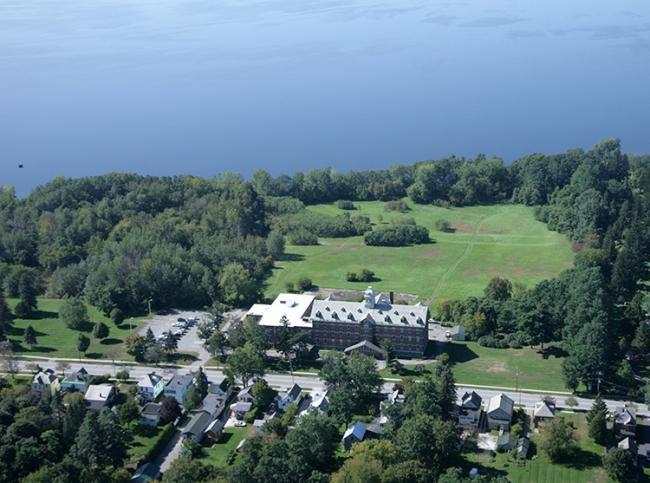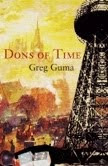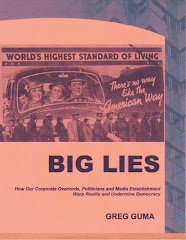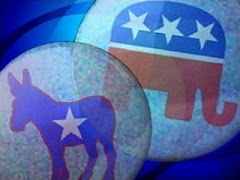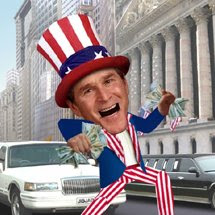(or, How Deregulation Trashed the US Economy and Government Intervention Became the Only Way Out)
Remember the panic-inducing headlines of 2008? Government Takes Over Troubled Mortgage Giants, Lehman Brothers Files for Bankruptcy, Bank of America Buys Merrill Lynch, and Stock Prices Plummet – that last one just as the government announced an $85 billion emergency loan to rescue insurance giant AIG. And that was just the beginning.
Next came the $700 billion bailout of “distressed” banks, a plan that gave Treasury Secretary Henry Paulson and the lame-duck Bush administration unprecedented power. We need to "remove the distressed assets from the financial system," argued Paulson, who had resigned as CEO of Goldman Sachs to become Treasury “czar” in 2006 – after amassing a personal net worth of $700 million during his time at the bank.
Even President Bush, in remarks to the country on Sept. 24, 2008, admitted that “democratic capitalism” – though he still considered it “the best system ever devised” – needed serious help. With the economy’s “fundamentals” clearly in jeopardy and the disaster wrought by deregulation and corporate excess exposed, government intervention had become the only way out.
Just one year later, nevertheless, the lessons of that economic meltdown have been largely forgotten. Instead, Republicans, media zealots and the paranoid Right have returned to their default position – crying “socialism” while blaming the government for what greed and unrestrained capitalism have wrought. The L-word – liberal – has been replaced by the S-word, and almost half of the population seems to believe that Obama is an alien radical intent on destroying the country from within.
Many people are currently living in a frightening fantasy world. According to an NBC/Wall Street Journal poll, 45 percent of all Americans believe that health care reform will create “death panels” that withhold medical care for the elderly, 55 percent think it will provide health insurance to illegal immigrants, and half say it will pay for women to have abortions – none of which are true. As sociology professor Peter Phillips explains, too many people, especially consumers of corporate television news, “are embedded in a state of excited delirium of knowinglessness.”
Given the current level of rampant misinformation and distortion of public discourse, it’s vital to remember how the economic crisis happened and what people really thought about it at the time. To begin with, it’s clear that the root of the problem tracks back to the deregulation era launched during the Reagan administration. What Bush I once called "voodoo economics" became the biggest redistribution of wealth since the New Deal.
The central article of faith in the "Reagan Revolution" was that money redistributed from the poor to the rich would produce a burst of productivity and economic growth. Give to the corporations and the wealthy, said "supply side" economists, and they will invest the money in new factories and technology, and the country will be restored to greatness. Did it work? Hardly.
Rather than putting their money into jobs, research or equipment, the country’s biggest businesses went on the largest merger binge in history, buying up companies in a trend that spelled less competition, less productivity, and more control of the economy in fewer hands. Multi-billion dollar war chests were assembled to finance takeovers of large oil and coal companies, communications giants, and prestigious financial institutions.
After a stock market meltdown in 1987, Wall Street advised the US Treasury not to meddle in financial markets. This paved the way for consolidation around large merchant banks, institutional investors, stock brokerage firms, and insurance companies. Complex speculative instruments – derivatives, options, futures, and hedge funds – were largely unregulated, becoming vulnerable to manipulation.
In 1999, the Financial Services Modernization Act – also known as the Gramm-Leach-Bliley Act – removed the remaining regulatory restraints on banking conglomerates. Repealing the Glass-Steagall Act of 1933, a New Deal reform put in place in response to corruption that had resulted in more than 5,000 bank failures following the 1929 Wall Street crash, it permitted commercial banks, brokerage firms, institutional investors and insurance companies to invest in each others’ enterprises and integrate their financial operations.
In short, the 2008 financial crisis had been building for a long time. But alarm bells didn’t start ringing until June 2007, when two hedge funds of the New York investment bank Bear Stearns lurched toward collapse because of their extensive investments in mortgage-backed securities. They were forced to dump assets as the trouble spread to major Wall Street firms such as Merrill Lynch, JPMorgan Chase, Citigroup, and Goldman Sachs, which had loaned the firm money.
Over that summer, German banks with bad investments in the US real-estate market got caught up in the crisis. But the most obvious sign of trouble was the Federal Reserve’s decision on August 9 to pump $24 billion into the US banking system through large purchases of securities; meanwhile, the European Central Bank made a record cash injection of $130 billion into its markets to shake off credit fears. On the same day, Wall Street suffered its second-worst decline of the year as the Dow Jones dropped by nearly 400 points.
The next day, the Fed pumped another $38 billion in temporary reserves into the financial system. But the government rejected a request for Fannie Mae and Freddie Mac to take on more debt. At the end of the month, President Bush announced a plan to use the Federal Housing Administration, which insures loans for low-income borrowers, to offer government-guaranteed loans to around 80,000 homeowners already in default. Big-time federal intervention was underway.
On Sept. 18, 2007 the Federal Reserve started cutting interest rates, citing the credit crunch on Wall Street and in the broad economy. The nation's central bank made cuts at seven straight meetings. It also agreed to start loaning money directly to Wall Street firms, rather than only to commercial banks, and to accept troubled mortgage-backed securities as collateral. In October, profits at Citigroup dropped sharply. One large financial institution after another reported heavy losses.
In January 2008, the Bank of America acquired Countrywide Financial in a deal that rescued the country's biggest mortgage lender. In February, Congress approved a $150-billion spending package to stimulate the sluggish economy. In March, on the verge of collapse and under pressure by the Federal Reserve, Bear Stears was forced to accept a buyout by investment bank JPMorgan Chase at a fire-sale price. The deal was backed by Fed loans – up to $29 billion in financing to cover potential losses. In July, the California mortgage lender IndyMac collapsed and troubles deepened for Fannie Mae and Freddie Mac.
Which brings us to September 6, 2008, when Paulson announced the takeover of Fannie and Freddie. That put the government in charge of firms that owned or backed more than $5 trillion in mortgages. The Treasury Department agreed to provide up to $200 billion in loans to the cash-starved firms, crucial sources of mortgage funding for banks and other lenders. It was a bid to reverse the prolonged housing and credit crisis. This was the same week when Presidential candidate John McCain announced that the “fundamentals of the economy are strong.”
A week later, on Sept, 15, 2008, Lehman Brothers, burdened by $60 billion in soured real-estate holdings, filed for bankruptcy after attempts to rescue the 158-year-old firm failed. Merrill Lynch also agreed to be acquired by the Bank of America, and AIG asked for a bridge loan of billions of dollars from the Federal Reserve. The $50 billion Bank of America deal created a bank that would rival Citigroup, the biggest US bank in terms of assets. Meanwhile, stocks fell, the Dow Jones sliding 504 points – the worst drop since the 9/11 attacks. Stocks also posted big losses in markets across much of the globe. The day became known as “Black Monday."
The next day, the government agreed to an $85 billion emergency loan to rescue AIG, saying failure of the company could hurt the already delicate financial markets and the economy. That was Tuesday. On Wednesday, the Dow lost about 450 points more. Markets around the world were also having a confidence crisis, and Russia shut down its market for a third day following its worst plunge since 1998.
On Thursday, the Federal Reserve, working with banks in Europe, Canada and Asia, pumped as much as $180 billion into money markets to combat a seizing up of lending. Republicans blasted the Treasury Department and Fed for orchestrating the AIG bailout, and the White House for not informing them of the plan. John McCain said he would fire SEC Chair Chris Cox (which the President can’t actually do), and Barack Obama called it evidence of the failure of deregulation and Bush-McCain policies.
A joke in Washington was that the crisis seemed to be turning deregulators into socialists – at least as far as business risks were concerned. That was a bit exaggerated. But for a while the crisis did force the whole country to take a look at Reagan’s old claim that “government is the problem.”
In the end, Congress settled on a 451-page bill called The Emergency Economic Stabilization Act. The week after it passed the Dow plunged by 500 points in one day, making the overall loss 5000 points for the year. Recession? Obviously. Depression? It was now a clear possibility.
Next, European central banks and the Federal Reserve cut interest rates at the same time in hopes of freeing up credit. Bloomberg News called this “an unprecedented coordinated effort to ease the economic effects of the worst financial crisis since the Great Depression.” The same day the Federal Reserve gave AIG a new $37 billion loan. That made it $120 billion total (of which executives and "high earners" quickly used more than $400,000 on resort lodging and spas). The market plunged again the very next day, this time over 650 points, down to 1995 levels.
By then, almost everyone agreed that government intervention was needed. Even some conservatives saw the light. On October 12, for example, James Baker III, Republican stalwart and the man to helped install George W. as president during the Florida election fiasco in 2000, said, “This is bigger than the private sector can fix by itself.”
Clearly, this wasn’t the dawn of socialism in America. But neither was it unprecedented. In 1917, the government had seized the railroads to make sure goods, weapons and troops moved smoothly during World War I. Bondholders and stockholders were compensated, and railroads were returned to private ownership after the war ended. During World War II, Washington had seized dozens of companies including railroads, coal mines and, briefly, the Montgomery Ward department store chain. In 1952, President Harry Truman had seized 88 steel mills across the country, saying that their owners were provoking an industry-wide strike that would cripple the Korean War effort. That time, the Supreme Court ruled the seizures an unconstitutional abuse of presidential power.
In 1984, the government took an 80 percent stake in the Continental Illinois National Bank and Trust. The bank had failed, in part, because of bad oil loans in Oklahoma and Texas. One of the country's top 10 banks at the time, Continental Illinois was considered "too big to fail" by regulators, who feared wider turmoil in the financial markets. Sound familiar? It was sold to Bank of America in 1994.
The nearest precedent for the 2008 “rescue” plan was the investments made by the Reconstruction Finance Corporation in the 1930s. It not only made loans to distressed banks. It bought stock in 6,000 banks, at a total cost of about $3 billion. When the economy eventually stabilized, the government sold the stock to private investors or the banks themselves.
Like most western democracies, the US government has clearly been operating with some socialist programs – within an undeniably capitalist system – for decades. Still, what are we actually talking about? We clearly don’t have the state running the economy. Rather, we have adopted programs designed to increase economic equality – and sometimes programs that have done the opposite. In other words, we’ve had redistribution of wealth. During the last few decades, it’s largely been redistribution toward the top.
So, given all the yelling and sign-waving, what do socialists actually believe? That capitalism unfairly concentrates power and wealth, creating an unequal society. Basically, a no brainer at this point. Yet they disagree about how much government intervention will work. Some certainly do advocate complete nationalization of production. But others prefer state control of capital within a market economy, while social democrats talk about selective nationalization of key elements in a mixed economy, along with tax-funded welfare programs. On the other hand, libertarian socialists don’t like state control and prefer direct collective ownership – workers coops, workers councils, basically workplace democracy.
Most libertarian socialists, like libertarians in general, weren’t happy about the 2008-2009 financial bailouts. Social democrats, in contrast, felt they didn’t go far enough. And most capitalists? Well, they decried the situation but went along. Some even chirped that “we are all socialists now” – at least as far as losses are concerned.
The truth is, Americans have been using socialist ideas – although not living in a socialist society – for many years, and the sky hasn’t fallen. But this doesn’t matter to the politicians and talking heads hawking “out of control” government and a hostile takeover of the country. The attempt to stir up fears about socialism, and link it to terrorism and un-American activity, is a cheap but tried-and-true political ploy. It’s also the latest incarnation of an ongoing culture war based on resentment, ignorance, and selfishness. The subtext is that we are not all equal, that being truly American means embracing a specific, very narrow set of values, and that the government shouldn’t be a force for equality.
But let’s give a conservative the last word. During the 2008 presidential campaign, George Will put it this way: “Ninety-five percent of what the government does is redistribute wealth. It operates on the principle of concentrated benefits and dispersed costs. Case in point: we have sugar subsidies. Costs the American people billions of dollars but they don't notice it it's in such small increments. But the few sugar growers get very rich out of this. Now we have socialism for the strong - that is the well-represented and organized in Washington like the sugar growers. But it's socialism none the less and it's not new.”

